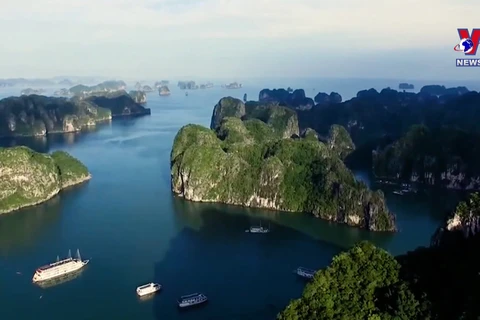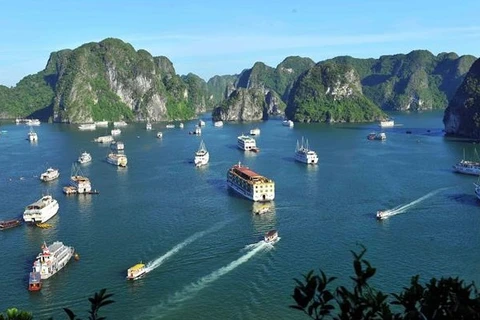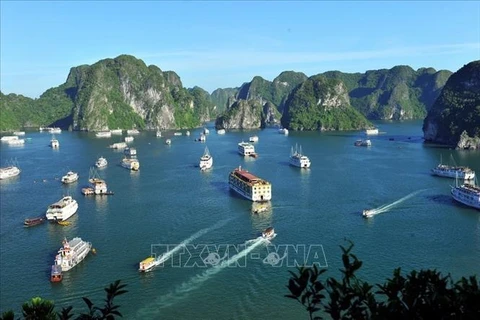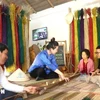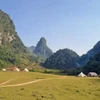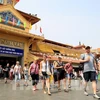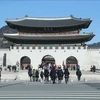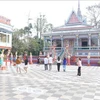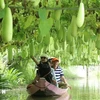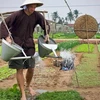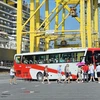Hanoi (VNA) - The travel magazine The Travel has listed Ha Long Bay in the northern coastal province of Quang Ninh and Cu Chi Tunnels in Ho Chi Minh City among the ten must-visit epic and adventurous places in Southeast Asia.
Ha Long Bay, which is situated in Northeast Vietnam, is regarded as one of the world's geographical beauties due to its emerald seas with hundreds of limestone islets, each capped with its distinct tropical jungle, the magazine said.
Ha Long Bay, literally “descending dragon bay”, is a must-see destination in Quang Ninh province. It was recognised as a UNESCO World Heritage Site in 1994 and 2000.
Tourists may enjoy the destination by diving and snorkeling, renting a canoe, or simply relaxing on the upper deck of their boat tour with a beverage in hand, the magazine added.
The bay spans 1,553 square kilometres and includes 1,969 islands of various sizes. It features thousands of limestone karsts and islets in various shapes and sizes. The limestone in the bay has gone through 500 million years of formation in different conditions and environments. The geo-diversity of the environment has created biodiversity, including a tropical evergreen biosystem, oceanic and sea biosystem. It is home to 14 endemic floral species and 60 endemic faunal species.
There are plenty of caves in the bay that can be entered including the Hang Sung Sot, with three mammoth caverns, and the Hang Dau Go, with superbly weird stalagmites and stalactites. For most people though, the highlight is simply cruising amid the karsts and soaking up the changing scenery of pinnacles as you pass by.
Since its recognition as a UNESCO natural world heritage in 1994, Ha Long Bay, around two hours from Hanoi, has found a spot on the global tourism map, with travel bloggers and filmmakers hailing its emerald waters and thousands of towering limestone pillars topped by rainforests.
According to US-based newspaper Business Insider, the beauty of Ha Long Bay makes it one of Vietnam’s top tourist sites. The website also recommends that tourists see the UNESCO-recognised site’s awe-inspiring limestone towers by boat.
Meanwhile, the Cu Chi cave system, situated 60 km beyond Ho Chi Minh City, is a vast network of subterranean tunnels that stretches to the Cambodian frontier. The tunnels served as a way of communication among settlements. Furthermore, the tunnels were easily reachable from HCM City, at about a one-and-a-half-hour trip.
Cu Chi Tunnels (Dia dao Cu Chi in Vietnamese) are situated in Cu Chi district - the outskirts northwest of Ho Chi Minh city. The underground networks are well-retained in two spots: Ben Dinh Tunnels (Ben Dinh hamlet, Nhuan Duc commune) and Ben Duoc Tunnels (Phu Hiep hamlet, Phu My Hung commune).
Despite the far distance from the vibrant center, this suburban district is worth visiting for its several tourist destinations along with the tunnel networks, such as fresh fruit gardens, Cu Chi Water Park, and Fosaco eco-village.
Cu Chi weather is another factor to consider before your trip. Owing to the tropical climate, Cu Chi has two distinct seasons: the rainy season (May to October) and the dry season (November to April) - the best time to visit Cu Chi Tunnels.
The Tunnels of Cu Chi, a gigantic underground tunnel system, was originally constructed under the jungle terrain, connecting tunnels among the hamlets and communes during the Indochina war (1945-1954) against the French colonialists. It served as hiding spots for Vietnam revolutionary troops to discreetly commute between regions and evade French scouts.
During the Vietnam war, the network had been expanded into an assembly complex for Communist guerrilla soldiers to house troops, transport communications, and supplies, receive medical treatments, take shelters from aerial bombardment, and mount surprise attacks, after which they could disappear underneath the ground. As a military headquarters, Cu Chi Tunnels played a pivotal role in the Vietnamese forces' resistance to the US army in South Vietnam.
Throughout the country's turbulent history, these iconic Saigon tunnels witnessed the sufferings in the fierce wars and symbolized the tenacity and resourcefulness of the Vietnamese people.
According to The Travel, Southeast Asia boasts a rich tapestry of distinct cultures and faiths, and it is considered a favourite part of the globe because of its beautiful beaches, delectable cuisine, and low rates of tourism./.



